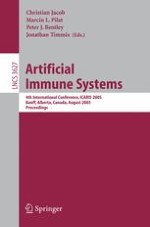2005 | Buch
Artificial Immune Systems
4th International Conference, ICARIS 2005, Banff, Alberta, Canada, August 14-17, 2005. Proceedings
herausgegeben von: Christian Jacob, Marcin L. Pilat, Peter J. Bentley, Jonathan I. Timmis
Verlag: Springer Berlin Heidelberg
Buchreihe : Lecture Notes in Computer Science
